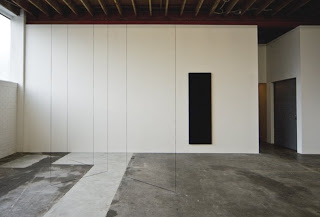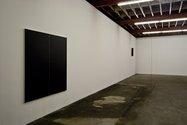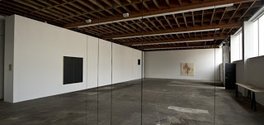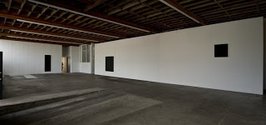John Hurrell – 21 May, 2009
For anyone interested in the continual reinventing of paint application and process, the spatial depth achieved by super dark fields or the perceptual nuances of linear sculptural form, this is a wonderful show. A treat for lovers of abstraction
Auckland
Fred Sandback, Gunter Umberg, Callum Innes
E=MC2
22 April - 29 May 2009
In this exhibtuion Andrew Jensen has selected these three artists to contribute two works each in a show that could be about quantum physics (the above 2 is meant to signify ‘squared’) - not so much referencing time and its experienced materiality, as phenomena such as black holes and the intangibility of surface.
Fred Sandback’s two minimalist sculptures are very distinctive with their use of tautly stretched double threads of black (sometimes grey) acrylic yarn to suggest planes. When not implying solid sheets, these wondrously intriguing lines push the eye up into the rafters to check out the nearby wiring and grid formations of the parallel wooden beams, or below, the oil, ink and paint stains on the oft repaired concrete floor.
The two Sandback works are quite different. One is a single box shape with no lid (like a U) in front of a long white wall. The other is of three vertical rectangles where two are on the same plane but separated by the distance of their own width. Projecting out from halfway between them, at a right-angle, is the third oblong.
In contrast to such linear austerity, Gunter Umberg’s paintings deal with spatial depth via the deepest and darkest of tones. Dry powdered black has been repeatedly applied on to wooden panels using a dammar binder brushed on in alternating horizontal and vertical strokes. This creates a very delicate woven texture. You’d swear it is from a thin light fabric but not so. The sheenless pigment creates a dense void that draws you in through the solid panels. One is like a very tall narrow doorway. The other is a square positioned high on the wall. It has thick bevelled sides that suspend the surface away from the wall so it hovers in front of it, while paradoxically creating a window through.
Callum Innes is widely known for the use of subtraction in his painting making processes, but in this show only one of the two paintings involves that, a work where a large rectangle of horizontally aligned viscous black paint has a centrally positioned thin vertical line cut down into it, and drawn on turps is used to remove inner residues.
The other work, the additive one, involves using a brush to flick specks and globules of thick red oil paint onto a canvas covered with wet shellac, and continually picking out and resetting bits of crumbling half dry paint by hand until the shellac hardens. Innes’ myriad splinterlike fragments, as with Umberg’s work, are deceptive. They look like traces remaining from the application of a solvent, but the ‘islands’ of paint remnants are much thicker. Many of the delicate traces come from slivers of oil skin that have later been relocated.
For anyone interested in the continual reinventing of paint application and process, the spatial depth achieved by super dark fields or the perceptual nuances of linear sculptural form, this is a wonderful show. A treat for lovers of abstraction.
John Hurrell






 Advertising in this column
Advertising in this column Two Rooms presents a program of residencies and projects
Two Rooms presents a program of residencies and projects



This Discussion has 0 comments.
Comment
Participate
Register to Participate.
Sign in
Sign in to an existing account.